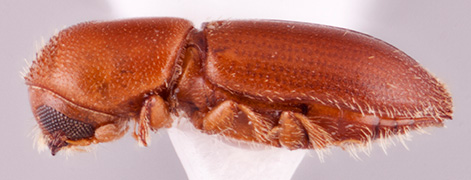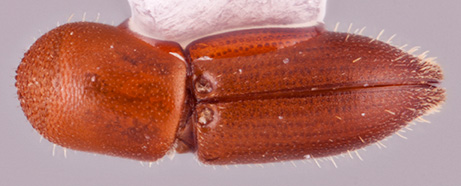Cryptoxyleborus subnaevus
|
Cryptoxyleborus subnaevus lateral; R.K. Osborn |
|
Cryptoxyleborus subnaevus dorsal; R.K. Osborn |
|
Cryptoxyleborus subnaevus declivity; R.K. Osborn |
|
Cryptoxyleborus subnaevus frontal; R.K. Osborn |
Taxonomic history
Cryptoxyleborus subnaevus Schedl, 1937a: 552
Diagnosis
2.2−2.7 mm long (mean = 2.46 mm; n = 5); 3.29−4.17 times as long as wide. This species can be distinguished by the pair of subcircular mycangial pits close to the scutellumscutellum:
a shield-like sclerotized plate located at the midpoint of the elytral base
on the dorsaldorsal:
of or relating to the upper surface; opposite of ventral
 elytral surface; antennalantennal:
elytral surface; antennalantennal:
pertaining to the antennae
funicle 4-segmented; and attenuateattenuate:
gradually tapering apically
 elytral apexapex:
elytral apexapex:
point or edge furthest from the body; opposite of base
 .
.
May be confused with
Distribution
Australia, 'Borneo', Brunei, India (Kerala), Indonesia (Kalimantan, Sumatra), Laos, East & West Malaysia, Myanmar, New Guinea, Philippines, Thailand, Vietnam
Host plants
recorded from Dipterocarpus, Dryobalanops, Pentacme and Shorea (Dipterocarpaceae) (Beaver and Hulcr 2008Beaver and Hulcr 2008:
Beaver RA, Hulcr J. 2008. A review of the ambrosia beetle genus Cryptoxyleborus Schedl (Coleoptera, Curculionidae: Scolytinae). The Coleopterists Bulletin 62: 133-153. https://doi.org/10.1649/1026.1)
DNA data
specimens not available for sequencing





